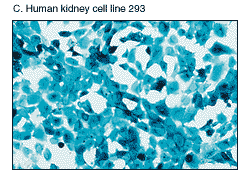Image used by permision.
("Electron microscopy..." 1996)
Baculovirus-Based DNA Transduction Systems
Fig.
1. Electron microscopy of baculovirus.
Image used by permision.
("Electron microscopy..." 1996)
The use of baclovirus as a means of gene transduction into mammalian cells is an effective, inexpensive method of cloning genes and expressing proteins. As one group of researchers said, "the baculovirus expression vector system (BEVS) has become one of the most versatile and powerful eukaryotic systems for recombinant protein expression" (Airenne K, et al 1999). Because of their utility and effectiveness, BVES are frequently used to study mammalian genes and proteins, as well as those of other organism types. BVESs provide high-levels of protein expression in a relatively short time-period (24-48 hours), and are a safe and practical way to study mammalian cell activity (Boyce 1999).
How BEVSs Work
One's
gene of interest is first transferred to an intermediate vector (usually
a plasmid) which is allowed to recombine with the baculovirus DNA in insect
cells. Inserts of over 20 kb are accepted into the viral DNA.
The intermediate plasmid contains a very strong promoter region upstream
from the insertion point. Also associated with the insertion region
in the plasmid are mammalian splicing and polyadenylation regions, which
along with the promoter, allows for a high rate of expression of the inserted
gene. The insertion area occurs in the lacZ gene, whixh acts
as a reporter to single out colonies containg the recombinant DNA.
Once the intermediate plasmid has recombined with the baculovirus DNA,
the virus is allowed to propagate in insect cells. It can then be
transfered to a wide variety of mammal cells for culturing and cloning.
Using white/blue selection made possible by the lacZ gene, colonies
of interest can then be isolated. A pictural representation of the
mammalian cell process is shown in Figure 2. (The figure and the
proceeding procedure come from Boyce 1999)



Fig. 2. Transduction of mammalian
cells with a baculovirus containing lacZ reporter gene.
Permission to use requested.
(Boyce 1999)
Advantages of BEVSs
BEVSs have
numerous features which make them ideal systems for many molecular biological
applications. They allow for "high expression vectors, limitless
size of the expressed protein, efficient cleavage of signal peptides and
processing of protein, post-translational modification and simultaneous
expression of multiple genes" ("Why do we..." 1999). BEVSs are useful
for the study of a variety of organisms in addition to mammals. As
researchers of chicken cytokines state, "the baculovirus expression system
is an appropriate system for the high-level expression of biologically
active ChIFN-gamma" (Lambrecht B, et al 1999).
References
Airenne K, Laitinen O, Alenius H, Mikkola J, Kalkkinen N, Arif S, Yeang-Hoong Y, Palosuo T, Kulomaa M. 1999. Avidin is a promising tag for fusion proteins produced in baculovirus-infected insect cells. Protein Expression and Purification 17(1): 139-145.
Boyce F. 1999 Jan. Non-chemical gene transfer into mammalian cells. InNovations:1-5.
“Electron microscopy of baculovirus.”
1996. Carsten’s Lab Home Page.
<http://meds-ss10.meds.queensu.ca/~carstens/baculovirus/Negstain.html>
Accessed 2000 Feb 21.
Lambrecht B, Gonze M, Morales D, Meulemans G. 1999. Comparison of biological activities of natural and recombinant chicken interferon-gamma. Veterinary Immunology and Immunopathology 70(3-4):257-267.
Home Page. 1999. Novagen. <http://www.novagen.com> Accessed 2000 Feb 21.
“Why do we use the Baculovirus Expression Vector System?” 1999. Protein Science Corporation. <http://www.proteinsciences.com> Accessed 2000 Feb 21.